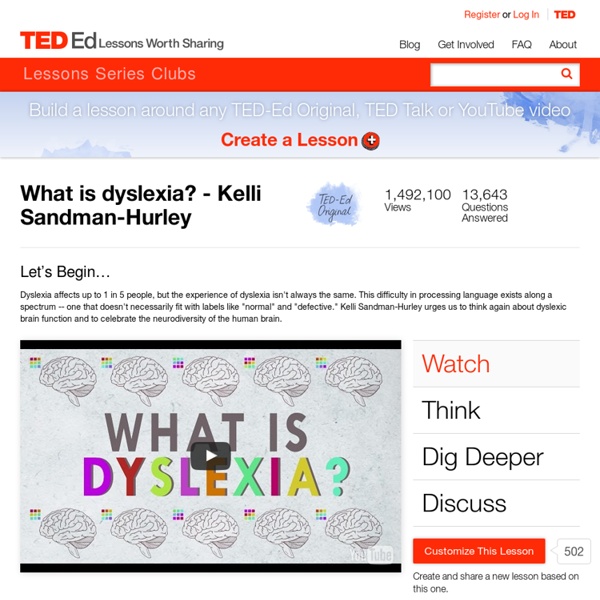



http://ed.ted.com/lessons/what-is-dyslexia-kelli-sandman-hurley
Related: Teaching English • Psycho • ListeningGet students learning by MAKING quizzes instead of TAKING quizzes. – EDTECH 4 BEGINNERS QuizPedia is a fun and engaging learning tool that can be used in primary education and onwards. And it’s free! How is it different to a typical quiz making tool? Quizzes aren’t new to the classroom but QuizPedia’s approach is. We flip the tables and transfer the task of making quizzes from teachers to students. Tests and quizzes are traditionally made and administered by teachers or schools to test student performance and development.
Why sitting is bad for you - Murat Dalkilinç Stop! Before Digging Deeper, go take a quick walk, get moving a bit and then come back! I promise you will feel better and perhaps even learn more! Why marking your students’ books should be the least of your priorities 1. Introduction Never, as in this day and age, secondary schools in the UK have made such a big fuss about the importance of marking student books and never has giving feedback been so tiresome and time-consuming for teachers. Based on the intuitively compelling notion – supported by recent research claims by the likes of Hattie – that a more cognitively demanding student involvement in the feedback-handling process significantly enhances learning, Modern Language teachers are now asked in many cases to place marking at the top of their priorities and engage in elaborate corrective approaches.
Can you guess where people are from based on their accents? Most of Georgia O’Keeffe’s work is in storage. Nearly half of Pablo Picasso’s oil paintings are put away. Not a single Egon Schiele drawing is on display. Since the advent of public galleries in the 17th century, museums have amassed huge collections of art for society’s benefit. Smrt English Hi! I am a teacher at the Spokane College of English Language ( I have been teaching the Smrt curriculum since 2011, and I'm always eager to teach new students using the latest technologies! I especially enjoy teaching writing and vocabulary. Hope to see you online in class soon!
10 Ted Talks Every English Student Should Watch TED is a series of informative, educational, inspiring and sometimes jaw-dropping talks that present ‘Ideas Worth Spreading’. Ted has attracted many of the world’s most important thinkers such as Larry Page, Bill Clinton, Bill Gates, Ken Robinson, and a few winners of the Nobel Prize. There is an emphasis on informing, educating and opening people’s eyes to new ideas, making them perfect for the classroom. Introducing Reported Speech Statements,Questions and Orders in a Different Way This week’s post was not supposed to be a grammar post, it just so happened to turn out like that. Come to think of it, I have been teaching lots of grammar lately so I shouldn’t be surprised if my brain is filled with ideas for grammar teaching. If I want my classes to be different from the ones I had when I was studying English at school (teacher-centred and book-centred), I cannot introduce all those digital tools I’m so keen on using and then go and spoil it all by asking students to read straight from a photocopy when it comes to grammar. I’m not saying it’s the wrong way to go about it, I’m just saying it’s not the way I teach or the way I’d like to be taught. Admittedly, grammar is grammar, but can we make it a bit more appealing to our students?
Eating insects Presenter: Every resort town in the US has a candy store, but one store in Pismo Beach, California, goes beyond the usual taffy and caramel apples. If Hotlix has its way, Americans will be snacking on everything from caterpillars and cockroaches to mealworm-covered apples. Larry Peterman is a candyman on a mission. For more than a decade he’s been promoting a valuable food source that most Americans find revolting. 5-Minute Film Festival: 5 Videos to Explore Growth Mindset We know there’s no silver bullet for improving learning outcomes for kids, and Stanford researcher Carol Dweck, who originated the concept of growth mindset, has spoken out recently against the misapplication of her findings. But with a deeper understanding of the idea, and more exploration around what proper implementation looks like, growth mindset has a lot of potential. If you’d like to learn more, or want to clarify the idea for the people around you, these five videos offer something for every audience—from preschoolers to parents and colleagues to college kids.
Improving IELTS Listening Through Connected Speech Ask your IELTS students which skill they are most worried about and listening will probably be top of the list. Most courses seem to put most emphasis on the productive skills, at the expense of reading and listening. This post will examine the inadequacies of IELTS course books in preparing students for the listening test and suggest some alternatives, principally raising awareness of connected speech and giving students time to analyse what they have heard post-listening. Pronunciation Difficulties Most of the listening problems students face stem from unfamiliarity with certain pronunciation features. The four main areas of difficulty are:
Ten things I did in 2016 that have significantly enhanced my teaching The year just gone was one of the best I have ever had in terms of professional development as a teacher, researcher, writer and CPD provider. In this blog I share ten things that I have tried out in 2016 that, in my view, have significantly enhanced teaching and learning in my lessons. 1.Doubled the exposure to receptive processing and delayed production One major change to my teaching has involved massively increasing my students’ exposure to comprehensible input before engaging them in production.